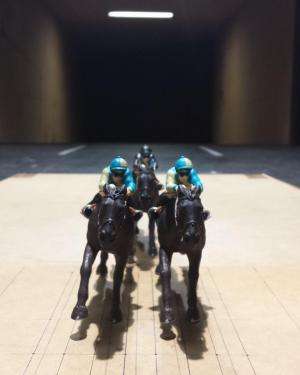Horse racing position cuts drag up to 66 per cent, study finds

Researchers from RMIT University in Melbourne, Australia, have revealed precisely how much different slipstreaming tactics reduce drag on a horse during a race.
Wind tunnel simulations showed jockeys who take advantage of slipstreaming, or drafting, by running their horse behind or alongside others can reduce aerodynamic drag force by up to 66 per cent – saving their horse critical energy.
The simulations conducted in RMIT's wind tunnel – using toy models that are exact miniature replicas of a racing horse and jockey – are the first in the world to measure the effect of slipstreaming on horses through wind tunnel tests.
The study comes as jockeys consider their strategies ahead of Australia's biggest horse race – the Melbourne Cup – on Tuesday, 4 November, part of the Melbourne Spring Racing Carnival.
Co-Chief Investigator, Professor Franz "Tino" Fuss, said slipstreaming was a standard strategy in sports such as cycling and speed skating to save athletes' power and energy.
"In a horse race, jockeys can use this same principle to give their horses an edge and help them reserve energy for that crucial final burst," Professor Fuss said.
"Our research for the first time quantifies how much drag is reduced through different slipstreaming tactics in a horse race.
"Jockeys, trainers, punters and betting companies should keep these findings in mind during the big days ahead of the Spring Racing Carnival."
The research showed the impact of different horse packs on drag (on average):
- Two horses in front of one horse: drag of trailing horse reduced by 66 per cent
- Four horses in a row: drag of last horse reduced by 54 per cent
- Two horses running closely behind each other: drag of leading horse reduced by 6.5 per cent, drag of trailing horse reduced by 38.5 per cent
- Five horses side by side: drag of centre horse increases by 25 per cent
From these principles and further results, the energy expenditure can be calculated throughout the race of each individual horse, as well as the overall energy savings when slipstreaming.
The research was conducted in the SportzEdge program of RMIT's Platform Technologies Research Institute, with co-Chief Investigator Professor Simon Watkins and aerospace engineering student Kevin Stark.
Provided by RMIT University




















